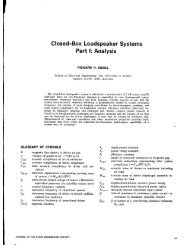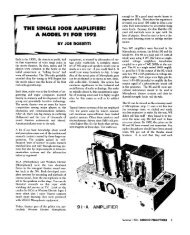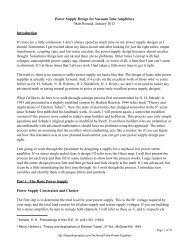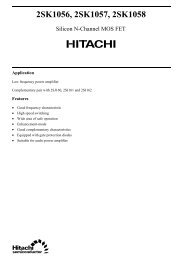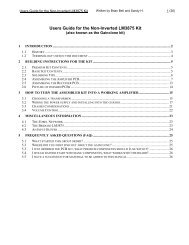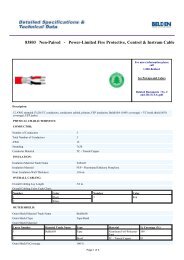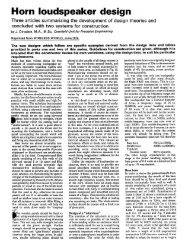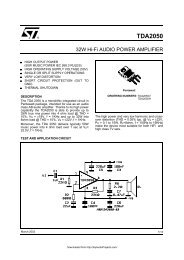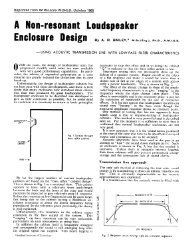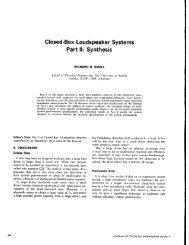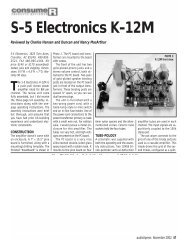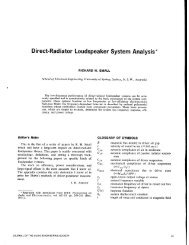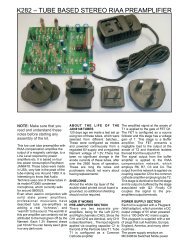Boozhound Laboratories JFET Phono Preamp Assembly manual ...
Boozhound Laboratories JFET Phono Preamp Assembly manual ...
Boozhound Laboratories JFET Phono Preamp Assembly manual ...
- No tags were found...
You also want an ePaper? Increase the reach of your titles
YUMPU automatically turns print PDFs into web optimized ePapers that Google loves.
<strong>Boozhound</strong> <strong>Laboratories</strong> <strong>JFET</strong> <strong>Phono</strong> <strong>Preamp</strong><br />
<strong>Assembly</strong> <strong>manual</strong> (rev.2)<br />
The <strong>Boozhound</strong>labs Philosophy<br />
The plan here is to offer kits that let the curious audiophile experience designs that they would otherwise have to build<br />
from scratch. The parts used in this kit are for the most part considered obsolete and are probably no longer being<br />
manufactured. I source this stuff from overseas via eBay.<br />
I think simplicity is a huge part of why classic equipment sounds so good, and modern stuff can sound so bad. In the days<br />
when capacitors and transformers were expensive, designers minimized the parts count in any design, and this approach<br />
is audible even when designing with modern devices. And for those of us who not only want to build stuff, but to<br />
understand how it works, simple designs are much more comprehensible, with no "black boxes" that we only<br />
understand through the abstraction of a spec sheet.<br />
Why not have fun building stuff instead of just pouring dollars into your system on the quest for ultimate-ness Part of<br />
the fun for me is the ability to try something new without having to shell out the big bucks.<br />
The <strong>JFET</strong> <strong>Phono</strong> <strong>Preamp</strong><br />
This is just about the simplest circuit possible that will accomplish what we need - reverse-RIAA equalization with gain.<br />
This is 2 <strong>JFET</strong> gain stages with a passive (no feedback) RIAA equalization network sandwiched between them.<br />
For more info, and to see how other builders have done something similar, you can search for a circuit called “Le Pacific”<br />
which is the same topology, but with a slightly different EQ section and parts values.<br />
Pretty nifty, huh Only 22 parts per channel including the power supply filter stuff. The <strong>JFET</strong> gain stages are straight from<br />
any electronics textbook. The RIAA filter section made up of R5, R8, C1, C2, and C3 are calculated using standard<br />
formulas. Nothing special here – except that almost nobody does it like this.<br />
Gain is approximately 40dB (about 30dB per gain stage, minus about 20dB for the RIAA EQ).
Inventory<br />
Start by verifying that you have all of the parts you need. I endeavor to make sure I send only complete kits, but it is<br />
always possible I missed something. If I screwed up and left something out, please email me immediately at<br />
jsn@boozhoundlabs.com and I will make it right.<br />
Here is what is included with each kit, with checkboxes to make it easy to verify that you have all of this stuff:<br />
( ) 1 Printed Circuit Board<br />
( ) 4 2sk170 transistors<br />
( ) 4 220uF electrolytic capacitor Nichicon Muse<br />
( ) 4 0.1uF PIO capacitor Russian K40-Y<br />
( ) 2 0.033uF PIO capacitor Russian K40-Y<br />
( ) 2 0.001uF PIO capacitor Russian K40-Y<br />
( ) 2 1uF PIO capacitor Russian K42-Y<br />
( ) 4 10 ohm resistor Brown, black, black, gold, brown<br />
( ) 4 49.9 ohm resistor Yellow, white, white, gold, brown<br />
( ) 4 100 ohm resistor Brown, black, black, black, brown<br />
( ) 6 3.16k resistor Orange, brown, blue, brown, brown<br />
( ) 2 28k resistor Red, gray, black, red, brown<br />
( ) 2 47k resistor Yellow, violet, black, red, brown<br />
( ) 2 100k resistor Brown, black, black, orange, brown<br />
( ) 2 1M resistor Brown, black, black, yellow, brown
<strong>Assembly</strong><br />
This is almost self-explanatory, but I will offer a few tips, and a few photos.<br />
It is generally a good idea to install the little stuff first and the big stuff afterwards, so that you aren’t melting the big<br />
stuff trying to get to the little stuff. Start with the resistors and the <strong>JFET</strong>s.<br />
There will be 2 matched pairs of <strong>JFET</strong>s. Use each pair in the same position in both channels – one pair will be Q1 in both<br />
channels, the other Q2. This will maintain the same amount of gain on both channels. It doesn’t matter which pair is Q1<br />
and which is Q2.<br />
I like to solder from the bottom of the board because it is easier to get to things, and the odds of overheating a part are<br />
lower because you are that much further from the part itself. Be sure to heat the pad and the leads sufficiently to let the<br />
solder flow all the way to the top of the board though. These boards have through-plated holes, so it will be easy.
These boards have traces only on one side, leaving the bottom side to be nothing but a huge ground plane. This will<br />
reduce grounding problems and make this a very quiet design.<br />
I also made the gap between the ground plane and the pads really huge so that it would be hard to accidentally ground<br />
out a component. I tend to use a soldering iron tip until it is far from pointy, so the spacing helps me keep everything<br />
tidy.<br />
The points where the components do attach to the ground plane will take a bit more heat to solder properly since the<br />
ground plane will act as a heat sink.<br />
Next install the capacitors. Or instead of “next” I should say “last” because you are done!<br />
The only thing left to do is visually inspect the solder joints to make sure everything looks good and there are no solder<br />
bridges or obvious cold solder joints.
Integration<br />
Connecting this to the various inputs and outputs is also super easy. The in and out pads are obvious. There is one more<br />
pad I probably should have labeled “gnd” that is for a wire to connect to the chassis, ideally at a ground lug where you<br />
connect the ground wire from your turntable.<br />
The pwr pads need to be connected to a source of roughly 24 volts filtered DC. There is a bit of filtering (more like<br />
decoupling) on the board, but not enough to filter AC. I use a mid-grade switch mode wall wart power supply for this<br />
because they are cheap, easy, and very quiet. An upgraded regulated power supply would be a nice upgrade I’m sure.<br />
There is no onboard fuse. The wall wart power supplies I imagine almost everyone will be using for this are internally<br />
current limited. If you use another power supply, a fuse might be a good idea. Current draw is less than 50 mA.<br />
I include the standard 47k load resistor, but feel free to change that to something that is better matched to your<br />
cartridge or stepup transformer or whatever.<br />
The mounting holes at the corners are designed for 4-40 thread screws. The boards measure 5.3” by 3.5” by 1.25”<br />
assembled<br />
Now go play a couple of those Steely Dan albums you buy every time you see them in the thrift store!<br />
-jsn



